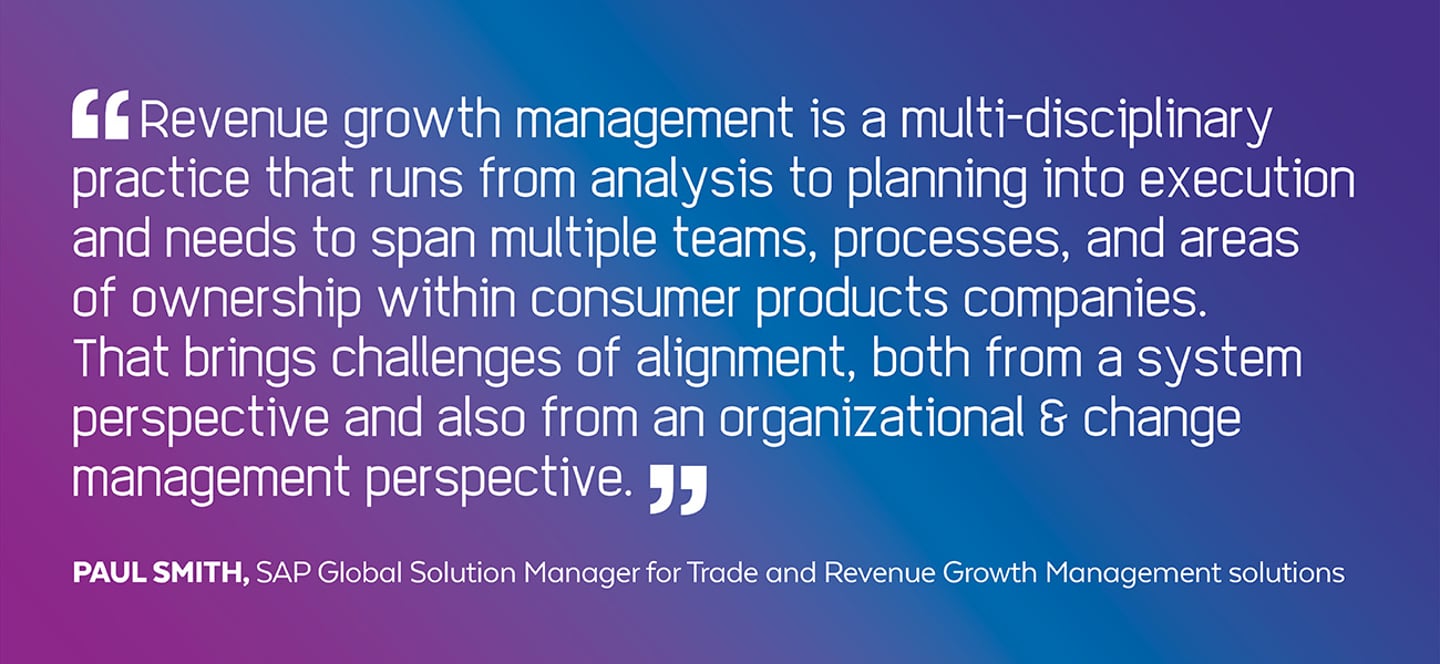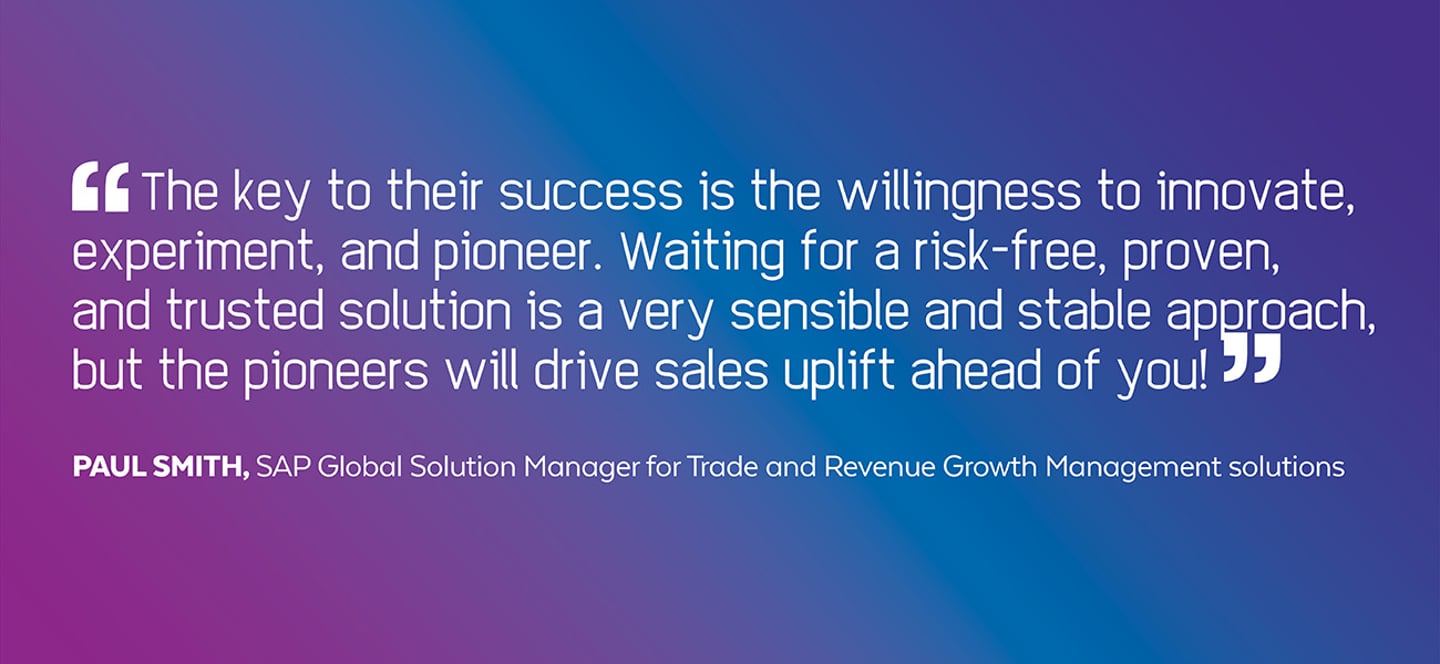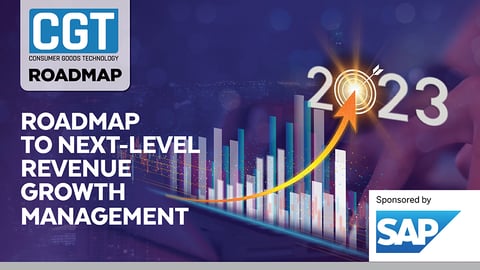Decoding Revenue Growth Management to Supercharge Profitability and ROI
The consumer goods industry is evolving all the time. When it comes to revenue growth management, leaders in the space are constantly trying to make sense of moving targets such as fragmented data, changing market dynamics, and fluctuating business goals.
Revenue growth management involves more than just maximizing profitability. At its heart, RGM involves analyzing and drawing together multiple sources of information and managing various portfolios across different geographies to hit business targets. In this exclusive Q&A, Paul Smith, SAP’s global solution manager for trade and revenue growth management solutions, outlines how consumer goods companies can strive for a more holistic RGM strategy that balances sustainable growth, enhanced profitability, and business success.
CGT: Why are today's consumer goods companies challenged with the ability to take a holistic approach to revenue growth management?
Paul Smith: Silos, separation, and systems. Revenue growth management is a multi-disciplinary practice, one that runs from analysis to planning into execution and needs to span multiple teams, processes, and areas of ownership within consumer products companies. That brings challenges of alignment, both from a system perspective and also from an organizational and change management perspective.
To do revenue growth management well, a company needs to be able to identify where sales performance can be improved and both revenue and margin increase. This means understanding and predicting where promotional spend is best utilized by asking the right questions:
- What areas of portfolio or assortment white space exist?
- What is the historical performance in granular detail?
- What competitors are doing and how pricing changes impact demand?
- What demand is forecasted?
- Can manufacturing and the supply chain meet demand?
This means working cross-functionally with stakeholders from manufacturing, supply chain, sales, marketing, analytics, and finance. However, getting cross-organizational consensus is a challenge.
CGT: How can data-driven recommendations play a key role in improving trade spending ROI?
Smith: Trade promotion planning often relies on key account managers’ detailed knowledge of their customers, coupled with a large degree of gut feel and intuition. For example, seasonal lines often require significant promotional activity, they are often variants of similar SKUs but expected sales volumes will be forecasted by looking at last year’s seasonal range and assuming a similar percentage uplift.
However, this is often done without a clear view on the success of the previous promotion and what is needed, is strong post-event analytics and insight. Consumption-based forecast models using detailed historical sales of the same or a very similar SKU would be even better to utilize in models to forecast the potential performance of the promotion.
A further improvement can then be done by testing and simulating different scenario options against the forecasted performance — trying different discount rates, tactics and supporting promotional spends, changing assortment, shifting dates, and changing the duration of promotions. This leads to examining many possible permutations to align on the most effective plan; however, manual analysis is extremely arduous and impractical to consider all the possible options. It’s like trying to crack Enigma with a pen and paper (or a spreadsheet) when this really calls for automation! The simulation and assessment of different options, then ranking the best performers (or those that meet the required goal) and driving a clear data-led recommendation of what combination of promotional characteristics provides the best outcome.
CGT: Can you share any examples of companies that have significantly improved their capabilities on this front? What was key to their success?
Smith: Some of the confectionary and snack brands are really pioneering in this area. Consumption-based forecasts and advanced analytical models use data from consumption, sales, supply chain, and trade and media spend to feed decision-science engines that make natural language-based recommendations and have simulated various outcomes to deliver a conclusion that has tested all those multiple factors.
The key to their success is the willingness to innovate, experiment, and pioneer. Waiting for a risk-free, proven, and trusted solution is a very sensible and stable approach, but the pioneers will drive sales uplift ahead of you!
CGT: What are some of the biggest misconceptions about optimizing trade promotions, and how would you debunk them?
Smith: One of the biggest challenges is that it’s not trusted by key account managers. It’s almost as if trade promotion optimization is seen as a technological black box that is hard to understand, difficult to use, and doesn’t deliver the claimed benefit or result. Keeping the user burden low is extremely important and optimizing trade spend without being a data scientist is entirely possible. A good optimization system should be like providing a key account manager with a planning tool that has a "Push Here" button.
Access to a tool that recommends clear and logical promotional improvements would be immensely helpful, showing a user a before and after of promotion terms and the predicted improvement will convince the staunchest naysayer and ultimately make more successful salespeople. Natural language recommendations are easier to act on than rummaging through spreadsheets, graphs, propensity models, price elasticity curves, and historical sales decompositions. While all of these sources have useful information, it’s much more efficient for a time-pressured key account manager if all of that information can be narrowed down to a clear recommendation of where to best spend the available promotional budget.







